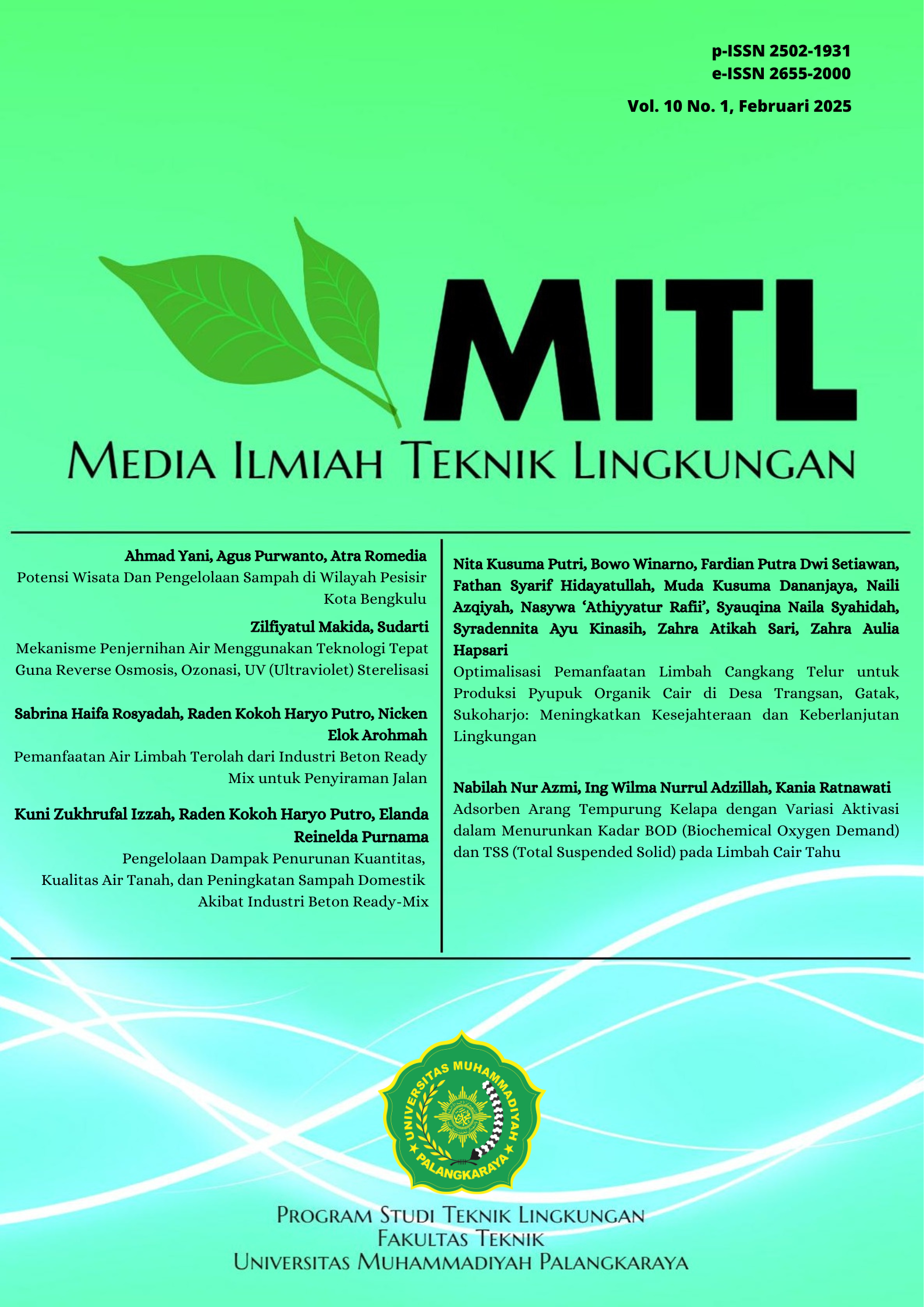Utilization of Treated Wastewater from the Ready-Mix Concrete Industry for Road Spraying Pemanfaatan Air Limbah Terolah dari Industri Beton Ready Mix untuk Penyiraman Jalan
Main Article Content
Abstract
The ready-mix concrete industry plays a crucial role in supplying concrete for various construction purposes. During its production and operational processes, this industry generates wastewater from laboratory activities, mixer van washing, and truck mixer cleaning. The generated wastewater is treated and planned to be reused for road spraying within the industrial area. This paper aims to analyze the characteristics of the generated wastewater and its potential impact on roads, and evaluate the efficiency of its reuse. The total volume of treated wastewater produced is 11.88 m³/day, containing parameters such as pH, TSS, Cl⁻, and SO₄²⁻. Based on the water quality measurements, the treated wastewater meets the quality standards set by the Ministry of Environment and Forestry for pH and TSS, and by Government Regulation No. 22 of 2021 for chloride and sulfate. Therefore, the wastewater is considered suitable for road spraying. The efficiency of using treated wastewater for this purpose reaches 43% during the dry season and 86% during the rainy season.
Downloads
Article Details

This work is licensed under a Creative Commons Attribution-ShareAlike 4.0 International License.
All rights reserved. This publication may be reproduced, stored in a retrieval system, or transmitted in any form or by any means, electronic, mechanical, photocopying, recording.
References
S. Martini, E. Yuliwati, and D. Kharismadewi, “Pembuatan Teknologi Pengolahan Limbah Cair Industri,” Distilasi, vol. 5, no. 2, pp. 26–33, 2020. Link: https://doi.org/10.32502/jd.v5i2.3030
R. Ginting and W. Malau, “Analisis Perbandingan Mutu Beton dengan Menggunakan Berbagai Cara Pengadukan (Ready Mix, Molen, dan Manual),” Jurnal Darma Agung, vol. 28, no. 1, pp. 106–114, 2020. Link: http://dx.doi.org/10.46930/ojsuda.v28i1.512
F. Sandrolini and E. Franzoni, “Waste Wash Water Recycling in Ready-Mixed Concrete Plants,” Cem Concr Res, vol. 31, no. 3, pp. 485–489, 2001. Link: https://doi.org/10.1016/S0008-8846(00)00468-3
S. Widodo, “Pemanfaatan Air Limbah Produksi Beton Ready-Mix Sebagai Pembuatan Beton Baru,” Inersia, vol. 6, no. 1, hlm. 1–10, 2010. Link: https://www.researchgate.net/publication/317357116_PEMANFAATAN_AIR_LIMBAH_PRODUKSI_BETON_READY-MIX_SEBAGAI_BAHAN_CAMPURAN_UNTUK_PEMBUATAN_BETON_BARU
A. A. Rahmani, Arifin and G. C. Asbanu, “Efisiensi Pengolahan Limbah Beton Ready-Mix dengan Metode Elektrokoagulasi dan Adsorpsi,” Jurnal Ilmu Lingkungan, vol. 20, no. 2, pp. 375–381, 2022. Link: https://doi.org/10.14710/jil.20.2.375-381
P. S. A. Sitogasa, E. Kurniawati, R. Novembrianto, and P. W. Prabowo, “Sistem Pengolahan dan Pemanfaatan Air Limbah Domestik (Studi Kasus pada PT. X),” Jurnal Ekologi, Masyarakat, dan Sains, vol. 4, no. 1, pp. 14–19, 2022. Link: https://doi.org/10.55448/ems.v4i1.74
E. Wardhani, S. A. Alsadilla, G. T. Mangopo, A. N. P. Nastiti, K. Fatin, G. G. Kurnia, and N. Ayuni., “Penentuan Timbulan Air Limbah dan Unit Instalasi Pengolahan Air Limbah di Central Business District Kota Harapan Indah Kota Bekasi,” Jurnal Teknologi Lingkungan UNMUL, vol. 7, no. 1, 2023. Link: http://dx.doi.org/10.30872/jtlunmul.v7i1.9774
I. A. C. V. Laksmi, G. A. Diputra, and G. A. P. C. Dharmayanti, “Perencanaan Persediaan Material pada Industri Ready Mix Concrete Menggunakan Metode EOQ (Economic Order Quantity) (Studi Kasus: PT. Sarana Beton Perkasa, Jalan By Pass Prof. Ida Bagus Mantra, Gianyar-Bali),” Jurnal Ilmiah Teknik Sipil, vol. 19, no. 2, pp. 140–147, 2015. Link: https://ojs.unud.ac.id/index.php/jits/article/view/24144
M. P. Amelia, Safaruddin, and M. M. Muzzaki, “Analisis Prosedur Pembuatan Semen pada PT. Semen Baturaja,” Jurnal Multidisipliner Bharasumba, vol. 01, no. 03, pp. 512–522, 2022. Link: https://doi.org/10.62668/bharasumba.v1i04.301
T. A. Gunarta, “Penurunan Surfaktan dan Fosfat Air Saluran Kalidami Menggunakan Media Kapur Semen dengan Proses Presipitasi Sedimentasi,” Institut Teknologi Sepuluh Nopember, 2019. Link: https://repository.its.ac.id/67174/
R. F. Rizka, P. W. Purnomo, and A. Sabdaningsih, “Pengaruh Total Suspended Solid (TSS) Terhadap Densitas Zooxhanthellae pada Karang Acropora sp. dalam Skala Laboratorium,” Jurnal Pasir Laut, vol. 4, no. 2, pp. 95–101, 2020. Link: https://doi.org/10.14710/jpl.2020.33689
X. Sui, S. Wang, Z. Leng, B. Yang, and G. Lu, “Clogging Evaluation of Porous Asphalt Pavement Using Ground-Penetrating Radar,” Measurement, vol. 216, no. 112939, 2023. Link: https://doi.org/10.1016/j.measurement.2023.112939
Y. A. Priastiwi, H. Wibowo, Purwanto, A. Hidayat, I. A. Ulayya, and N. Carita, “Pengaruh Air Laut Terhadap Kuat Tekan, Permeabilitas, dan Mikrostruktur Beton Geopolimer dengan Fly Ash dan Tanah Putih Sebagai Pengganti Semen,” Media Komunikasi Teknik Sipil, vol. 30, no. 1, pp. 65–74, 2024. Link: https://doi.org/10.14710/mkts.v30i1.63604
I. Nistiyanti and E. Hidayanto, “Studi Pemanfaatan Sifat Pembiasan Cahaya pada Portable Brix Meter Untuk Menganalisis Hubungan Konsentrasi Larutan Sukrosa (C12H22O11) Terhadap pH,” Youngster Physics Journal, vol. 4, no. 3, pp. 231–236, 2015. Link: https://ejournal3.undip.ac.id/index.php/bfd/article/view/9105
Y. Zou, S. Wu, A. Chen, Q. Liu, S. Amirkhanian, S. Xu, C. Yang, P. Wan, H. Xu, and Z. Lu, “Comprehensive Properties Assessment of Asphalt Binder Under Aqueous Solutions with Different pH Values and Its Gradient Damage Behaviors,” Constr Build Mater, vol. 414, 2024. Link: https://doi.org/10.1016/j.conbuildmat.2024.134938
H. Hardianti, S. A. Kristiawan, and Wibowo, “Pengaruh Konsentrasi Klorida Terhadap Laju Penetrasi Ion Klorida ke dalam Beton High Volume Fly Ash-Self Compacting Concrete (HVFA-SCC),” Matriks Teknik Sipil, vol. 5, pp. 974–980, 2017. Link: https://doi.org/10.20961/mateksi.v5i3.36727
S. A. Chini and W. J. Mbwambo, “Environmentally Friendly Solutions For The Disposal of Concrete Wash Water From Ready Mixed Concrete Operations,” dalam CIB W89 Beijing International Conference, Okt 1996, pp. 21–24. Link: https://www.researchgate.net/publication/237249107_ENVIRONMENTALLY_FRIENDLY_SOLUTIONS_FOR_THE_DISPOSAL_OF_CONCRETE_WASH_WATER_FROM_READY_MIXED_CONCRETE_OPERATIONS
A. A. Kadir, S. Shahidan, L. H. Yee, M. I. H. Hassan, and M. M. A. B. Abdullah, “The Effect on Slurry Water As A Fresh Water Replacement in Concrete Properties,” in IOP Conference Series: Materials Science and Engineering, Institute of Physics Publishing, 2016, pp 1–9. Link: https://iopscience.iop.org/article/10.1088/1757-899X/133/1/012041
F. Wang, X. Qin, W. Pang, and W. Wang, “Performance Deterioration of Asphalt Mixture under Chloride Salt Erosion,” Materials, vol. 14, no. 3339, pp. 3–15, 2021. Link: https://pubmed.ncbi.nlm.nih.gov/34204241/
D. S. Handayani, “Kajian Pustaka Potensi Pemanfaatan Greywater Sebagai Air Siram WC dan Air Siram Tanaman di Rumah Tangga,” Jurnal Presipitasi, vol. 10, no. 1, pp. 41–50, 2013. Link: https://doi.org/10.14710/presipitasi.v10i1.41-50
